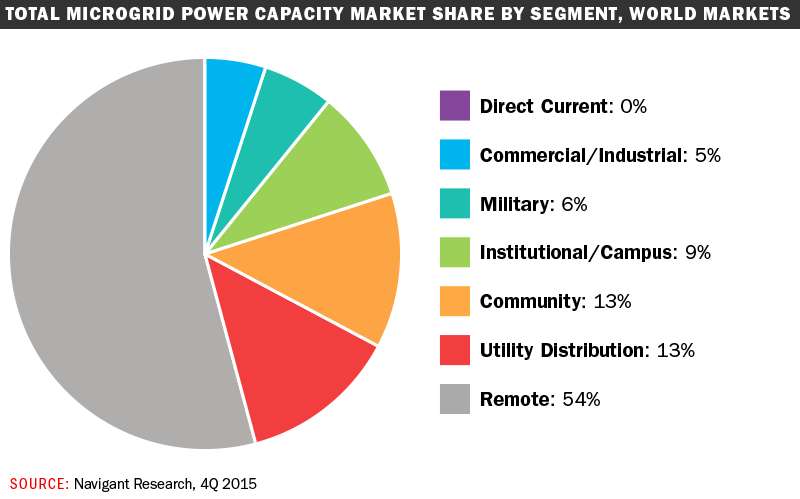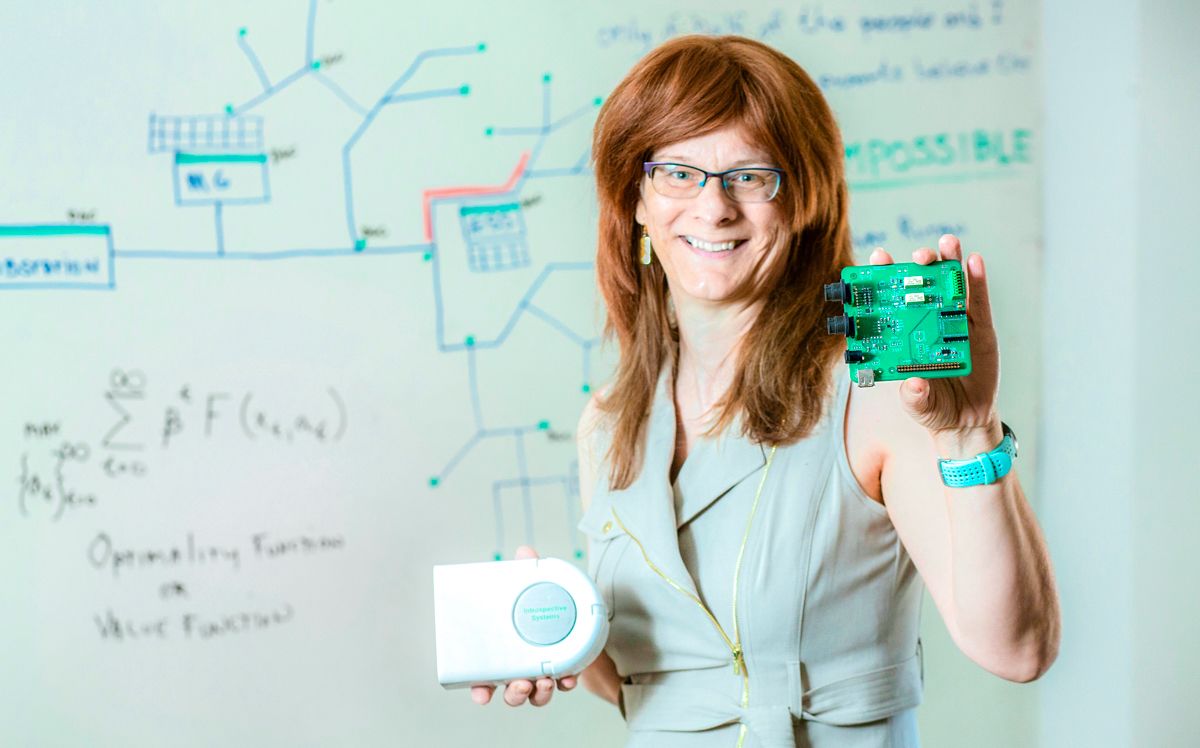
Across Maine, momentum grows for ‘smart’ electricity microgrids
 Photo / Tim Greenway
Kay Aikin, CEO of Dynamic Grid in Portland.
Photo / Tim Greenway
Kay Aikin, CEO of Dynamic Grid in Portland.
Why spend $1.7 million to replace an old underwater cable supplying diesel power when you can build something new that’s more cost- and energy-efficient?
That’s the philosophy behind a plan to build a so-called smart microgrid that will supply the midcoast island of Isle au Haut with solar power. The innovative system will use real-time pricing signals to balance supply and demand with real-time control of heat pumps and cost-effective energy storage.
It’s known as transactive energy, and over a 20-year time horizon will reduce consumer power costs by 17%, adjusted for inflation. Over that same period, houses with heat pumps will see an estimated 76% cut in carbon emissions compared to a normal fuel oil-heated house.
Construction is slated to start this September using a design by Introspective Systems. The nine-employee Portland company is at the forefront of a clean-energy revolution that’s starting with projects in remote communities like Isle au Haut but with great potential to make Maine’s main power infrastructure statewide safer, greener and more affordable.
“As we’re electrifying more, I think grid planning and particularly microgrids are opportunities to become more strategic,” says Martin Grohman, executive director of the Environmental and Energy Council of Maine, by phone from an electric car.
While regulatory and financial obstacles will keep that from happening overnight, small policy steps forward include a revived bill on microgrids (LD 13) sponsored by state Rep. Mick Devin, D-Newcastle, and a federal energy-storage bill sponsored by U.S. Sen. Angus King, I-Maine.
Innovators leading the charge
As regulatory change lags, Maine-based companies including Introspective Systems and Ocean Renewable Power Co. Inc. are leading the move towards microgrids with projects in Maine and elsewhere.
“There’s a lot of trends happening right now, and one is that people are looking at ‘How do we make the electrical grid reliable and more resilient?’,” says Kay Aikin, co-founder and CEO of Introspective Systems, now doing business as Dynamic Grid.
As Maine makes the transition to 100% carbon-free energy by 2045 and moves away from fossil fuels and toward more renewables in a process known as beneficial electrification, “microgrids are a key part of that.”
A December 2019 report by New York-based market research and consulting firm Reports and Data backs that up, predicting the global smart grid market to reach $93 billion by 2025, from $22 billion in 2018. Technology-enabled microgrids are seen as a way to lower electricity costs in the long run and get more power from clean-energy sources.
Nationwide, the majority of microgrids operating today are pilot projects or R&D experiments, with remote areas accounting for more than half of the market (54%) as shown in a 2016 report by Navigant Consulting Inc. Other users are hospitals and former military bases like Brunswick Landing, which gets green power from a Midcoast Regional Development Authority-owned grid.

From Maine to West Africa
Besides the Isle au Haut project, Introspective Systems is in the bidding for a solar project on Matinicus Isle Plantation in a public procurement request for proposals that a spokesperson says has attracted strong interest. It’s also working on a project in Alaska, has projects in preliminary design across New England and the Mid-Atlantic. It also has projects in design in Israel and Norway and is talking to potential customers in Nigeria, Senegal and Ireland.
To better reflect its work designing dynamic energy controls powered by artificial intelligence, it’s now doing business as Dynamic Grid as it gets ready to make the jump from research to commercialization of the controllers it’s developed for Isle au Haut and other projects.
Though not the only company to design artificial intelligence-based architecture for microgrids, Aikin says she knows of no more secure systems.
“I get a lot of researchers who say, ‘It can’t be done,’ says Aikin, a Pennsylvania State University engineering graduate who spent her career as an energy engineer, architectural designer, business development executive and co-founder of Introspective Systems, which was incorporated in 2010, started operations in 2013 and employs nine people. Her answer: “It can be done.”
She says it’s done with lots of “heavy-duty math,” using algorithms developed by economists in the 1950s, including Nobel Laureate Kenneth Joseph Arrows, and market-based principles. The Isle au Haut system will balance power supply and demand with a grid that captures and stores surplus power via batteries and hot-water heat pumps.
“There’s an analogy for everything in the grid,” says Aikin, who likens a power generator in one of her company’s microgrid systems to a Walmart warehouse, lines in the grid to store shelves and the battery to the back retail stock. “I can pick out every single part of the economic system and match it to the grid.”
Ocean of opportunity
Like Aikin’s company, Ocean Renewable Power has a lot going on.
In Maine, it has an existing licensed test site in Cobscook Bay on the Eastport-Lubec border that connects directly to Versant’s regional grid. Eventually it plans to transition its tidal power development to the Western Passage body of water on the U.S. side of the Maine-New Brunswick border, adjacent to Eastport. That will be developed in conjunction with a smart microgrid project that would operate as part of the regional Versant grid or separately as the situation calls for, according to ORPC President John Ferland.
The Portland-based company also operates an engineering and electronics laboratory and product testing and assembly facility in Brunswick, which Ferland says is not part of Brunswick Landing’s TechPlace electricity service or solar installation.
It also has a three-year river current-powered microgrid project in Igiugig, Alaska, that aims to help the remote community reduce its use of diesel by 90%.

“This is the preeminent hydrokinetic project in the United States today and a model renewable energy solution for remote communities globally,” says Ferland.
Outside the country, it’s completing a feasibility analysis of a microgrid and river power system project in Chile and awaiting funding announcements or work agreement approvals for projects in three Canadian provinces.
“In the course of doing all this work in Maine,” Ferland says, “an international market opened up for us, and the market is remote regions that pay a higher kilowatt per hour for diesel. These are communities that can’t connect to the regional grid and have no natural gas pipeline, so they take care of themselves.”

He’s equally excited about future opportunities for microgrids in Maine, noting that maturing technology is moving the industry from pure research and development to selling products.
“Based on our experience elsewhere, and by going into the market with smaller systems, what we are seeing is the opportunity for our systems that will eventually become part of public infrastructure,” he says. “If a new bridge is being built, it will be hydrokinetic power.”
Long road ahead
Among the hurdles to widespread microgrid development: regulation and costs.
“Right now you need to be able to completely separate from the grid. That’s a pretty rigid structure — it’s all or nothing,” says Sue Ely, climate and clean energy policy advocate and staff attorney at the Natural Resources Council of Maine. “It seems like if you want to expand it beyond island communities and military bases, you’re going to need a little bit of regulatory flexibility.”
Cost is another challenge even for institutions like Bates College, which became carbon-neutral last year. It’s looking at ways to get more solar production on campus as it maps out its sustainability goals for 2030.
“We’re thinking about what would be the pros and cons of microgrids,” says the school’s sustainability manager, Tom Twist. At the moment he sees the costs far outweighing the benefits, estimating that it would cost millions to store more energy on campus. “We’re hoping that comes down in price in the near future, but right now I think my business office would laugh me out of the room.”
On the national stage, King, a former energy entrepreneur who founded a startup that developed and operated electrical energy projects he sold after five years, is a vocal champion of microgrids.
“I think microgrids are important, not only for Maine but for the country, as a national security issue,” says King, who serves on the Senate’s Energy and Natural Resources and Armed Services committees.
“One of the threats to our country in terms of cyber intrusion is to the grid,” he tells Mainebiz by phone from coastal Georgetown. “If you’ve got a large centralized, totally interdependent grid, then a strike is more devastating than if you have separate microgrids that can withstand that kind of attack, so I view that as important from a national security concern — and then more basically in Maine, more secure for grid resilience in a storm.”
Noting that both are equally important, he adds: “If you have smaller centers and nodes that are self-healing and not necessarily reliant on the overall large grid, then you’re more self-sufficient and more resistant to a loss of service, whether it’s because of a cyber attack or a tree falling down.”
But King doesn’t see grids having much of a future without the ability to store excess energy for use during non-peak production hours, and has been a key proponent on Capitol Hill of storage as the real key to a green energy future.
To make that happen, he is co-sponsor of the Joint Long Term Storage Act (S.2048), introduced last year and reported out of the Senate’s Energy and Natural Resources Committee. It seeks to improve long-duration energy storage technology through a strategic collaboration between the U.S. Department of Defense and the Department of Energy.
“It’s a bipartisan bill, it has a lot of good things in it, and one of them is more emphasis on storage, particularly research,” King says. “The key is bringing the cost down. That is happening, but we want to continue to accelerate the downward trend of cost per kilowatt hour.”














0 Comments